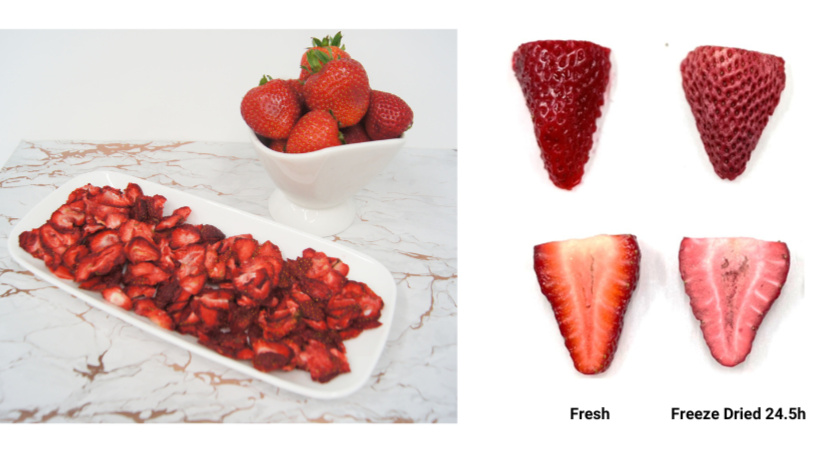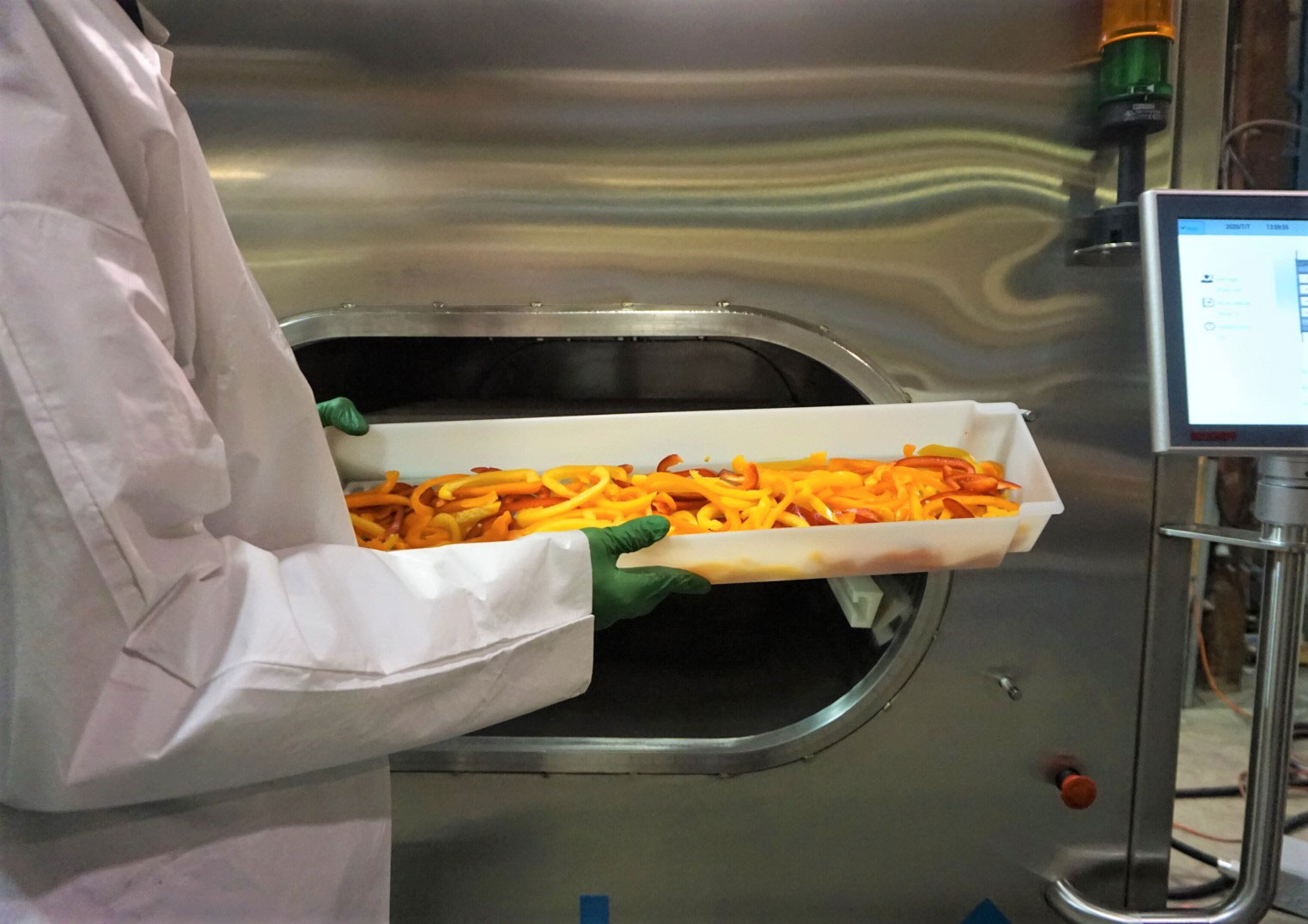AN ALTERNATIVE TO FREEZE DRYING: VACUUM MICROWAVE DRYING
RAPIDLY DRY WITH MICROWAVE
Curious about vacuum microwave drying as an alternative to freeze drying? NuWave Research’s vacuum microwave drying is a dehydration method for food materials similar to freeze drying, but much faster and better at preserving material quality and appearance. As a result, it’s often used as an alternative to freeze drying. In this post, we’ll look at both of their drying techniques, end products, and operations.
How do they Work?
Both techniques dry material in an oxygen-free environment with help from vacuum to lower the boiling point of water, but their overall process and temperatures differ.
VACUUM MICROWAVE DRYING
Microwave drying under vacuum is a fast one-step process, that works by creating a vacuum and then applying heat (sometimes referred to as microwave energy vacuum drying). Total processing time can be as little as 30 minutes. It combines the benefits of vacuum and microwave’s uniform volumetric heating (60°C or below) to remove water from the material. The process starts with waveguides directing microwaves into a chamber, while a vacuum pump decreases the chamber pressure. Polar molecules in the material absorb the microwaves and try to align to their electric field, causing rapid vibration and friction between molecules. This friction converts microwave energy into thermal energy, increasing the temperature of the material and evaporating water.
FREEZE DRYING
Freeze drying is an often lengthy three-step tray-based process. The total processing time ranges from 10 hours to multiple days. It starts by freezing the material to temperatures between -45°C to -35°C and lowering the chamber pressure with a vacuum pump (a process called lyophilization). Then, the primary drying phase removes water by slowly adding heat to the bottom of the trays. This causes the ice in the material to change directly from a solid to a vapor (a process called sublimation). This sublimation stage is a very slow process that requires precise control of temperature and pressure to prevent the ice from turning to liquid water. Finally, the secondary drying phase (sometimes referred to as desorption) reduces the residual moisture content as much as possible by raising the temperatures higher than during the primary drying phase.
Compared to freeze drying, microwave drying under vacuum is a relatively simple process. It applies microwave energy directly to the material and does not require freezing the material before drying. In addition, it has the flexibility to process material at various starting temperatures depending on what’s best for the application (from frozen, to room temperature, to pre-heated).
HOW DOES Freeze and vacuum microwave drying AFFECT END-PRODUCT?
Both techniques can be ideal for drying fragile or heat-sensitive materials. This is because their relatively low temperatures and oxygen-free environment are ideal to retain material qualities. Some examples of retained material qualities in food include nutrients, vitamins, flavors, and antioxidants.
Appearance: Dull & Bleached VS Bright & Fresh
Vacuum microwave drying is often better at preserving original quality, like colours, than freeze-drying. This is because it’s much faster. As a result, there’s usually less heat exposure over time, leading to much less colour degradation. For instance, freeze-dried strawberries are a dull bleached pink, whereas vacuum microwave dried strawberries are a natural vibrant red.
Visual comparison of fresh strawberries in a bowl next to sliced vacuum microwave dried strawberries on a plate, which better retain their bright and fresh appearance compared to the freeze dried strawberries by our R&D team.
Moisture Content: Varies with Drying Technique
The final moisture percentage of products can vary between the two methods. Freeze-drying achieves between 4-1% and vacuum microwave between 40-0.01% and below, depending on the material and end-product goal.
Texture: Create A Crunch with Vacuum Microwave Drying
Texture often differs between the two methods, with vacuum microwave drying creating crunchy or chewy bites and freeze-drying sometimes causing spongy textures.
Processing Time: Rapidly Dry with Vacuum Microwave Drying
Processing time fluctuates for both methods depending on the material, but generally speaking, vacuum microwave drying is a faster process. It can be completed anywhere between 10 minutes to 2 hours. Whereas freeze drying takes between 10-52 hours depending on the material. This is because freeze-drying is a slow three-step process, that risks the final product quality if rushed. For instance, shortening the freezing stage could result in uneven freezing, and ultimately uneven drying in the material. While trying to speed up the sublimation stage could risk causing the ice to melt rather than sublimate, potentially leading to a loss of nutrients, flavors, and aromas.
Freeze Drying and Vacuum Microwave Drying OPERATIONS
Energy Source & Efficiency
With regards to energy, both are electric emission-free drying technologies that may require little to no installation of services (like gas lines) compared to gas powered systems. Although, freeze drying is more energy intensive as it requires about 50% more energy than vacuum microwave drying. This is because freeze drying is a slow process that requires freezing the material, followed by two long drying phases. While vacuum microwave drying is a rapid and energy-efficient one-step process, and the majority of the energy is absorbed by the material.
Operating Conditions
Both techniques operate at relatively low temperatures and in an oxygen-free environment to preserve material quality. Freeze drying is often used as a single drying step in a production process, but vacuum microwave drying can be used as the single drying process or in combination with another drying method (like freeze drying) for pre- or post-processing. Adding vacuum microwave drying to an existing drying process can be ideal to potentially increase throughput and energy-efficiency (and lower emissions if added to a process that uses natural gas).
Machine Configuration
In terms of systems, both methods have closed systems that can capture any volatized components due to their vacuum pump. Freeze-dryers are often continuous or batch tray-based systems that require a larger footprint and more space. Vacuum microwave systems are compact machines that can be manufactured based on the client’s material and processing needs. For example, they can be continuous or batch systems with tray- or mixer-based material handling.
CONCLUSION: Vacuum Microwave Drying, An Alternative to Freeze Drying
Both techniques offer low-temperature drying, ideal for preserving original material quality, like nutrients in food products and materials. But vacuum microwave drying is better at retaining the original material appearance, like colors. This makes it ideal for fresh-looking single ingredient dried fruit snacks. In addition, vacuum microwave drying is faster and more energy-efficient compared to freeze drying. This is because freeze drying is a long three-step process that can take more than 2 days. Whereas vacuum microwave drying is a relatively simple and fast process that can usually be completed in less than 2 hours. Ultimately, the choice between drying methods depends upon the material, processing time, operation parameters, and end-product goal.
Ready to explore microwave Processing?
CURIOUS ABOUT NUWAVE RESEARCH & Our vacuum Microwave Drying?
Read our blog, visit our LinkedIn, or view the team page to learn more about our microwave processing expertise.


